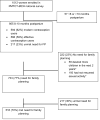Uptake and correlates of contraception among postpartum women in Kenya: results from a national cross-sectional survey
- PMID: 29031815
- PMCID: PMC5861297
- DOI: 10.1016/j.contraception.2017.10.001
Uptake and correlates of contraception among postpartum women in Kenya: results from a national cross-sectional survey
Abstract
Objective: The objective was to characterize uptake and correlates of effective contraceptive use postpartum.
Study design: We analyzed data from a national, cross-sectional evaluation of prevention of mother-to-child HIV transmission programs that enrolled women attending 6-week or 9-month infant immunization visits at 120 Kenyan maternal and child health clinics. We classified women who resumed sexual activity postpartum and did not desire a child within 2 years as having a need for family planning (FP).
Results: We included 955 (94%) of 1012 women 8-10 months postpartum in the analysis. Mean age was 25.8 years and 36% were primigravidas. By 9 months postpartum, 62% of all women used contraception and 59% used effective contraception [injectables, implants, intrauterine devices [IUDs], oral contraceptives [OCs] and tubal ligations]. Most contraceptive users (61%) used injectables, followed by implants (10%), OCs (6%), IUDs (4%) and condoms alone (2%). The majority (n=733, 77%) had a need for FP, and 67% of 733 women with FP need used effective contraception. Among women with a need for FP, effective contraception use was higher among those who discussed FP in postnatal care (PNC) than who did not discuss FP in PNC [prevalence ratio (PR) for PNC alone: 1.35, 95% confidence interval (CI): 1.16-1.58; PR for PNC and antenatal care (ANC): 1.42, 95% CI: 1.21-1.67; p=.001 for both].
Conclusions: Two thirds of postpartum women with a need for FP used effective contraception at 9 months postpartum, and use was associated with discussing FP during PNC.
Implications: Integrating FP counseling in ANC/PNC could be an effective strategy to increase effective contraception use.
Keywords: Child health; Contraception; Kenya; Maternal health; Postpartum.
Published by Elsevier Inc.
Conflict of interest statement
Figures




References
-
- United Nations. Transforming our world: the 2030 Agenda for Sustainable Development. 2015
-
- Brown W, Druce N, Bunting J, et al. Developing the “120 by 20” goal for the Global FP2020 Initiative. Stud Fam Plann. 2014;45:73–84. - PubMed
-
- Rutstein S. Further evidence of the effects of preceding intervals on neonatal, infant, and under-five mortality and nutritional status in developing countries: evidence from the Demographic and Health Surveys, DHS Working Papers, Calverton, MD, USA. Macro International. 2008;(41) - PubMed
-
- Moore Z, Pfitzer A, Gubin R, Charurat E, Elliott L, Croft T. Missed opportunities for family planning: an analysis of pregnancy risk and contraceptive method use among postpartum women in 21 low- and bottom-income countries. Contraception. 2015;92:31–9. - PubMed
Publication types
MeSH terms
Grants and funding
LinkOut - more resources
Full Text Sources
Other Literature Sources
Medical
Research Materials

